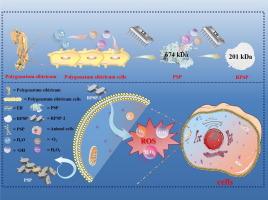Efficiently radiation-induced degradation and extraction of Polygonatum sibiricum polysaccharides and its excellent ROS scavenging properties
IF 13.2
1区 工程技术
Q1 ENGINEERING, CHEMICAL
引用次数: 0
Abstract
The traditional Chinese medicine Polygonatum sibiricum (PS) possessed anti-inflammatory and reactive oxygen species (ROS) scavenging properties. Currently, the extraction method for Polygonatum sibiricum polysaccharides primarily relies on traditional techniques, which exhibit low extraction efficiency and limit ROS scavenging activity. The present study aims to enhance the then-current low extraction yield and poor activity of polygonatum polysaccharide by innovating the technology of electron beam radiation extraction and degradation cycle. The optimal radiation extraction process for obtaining Polygonatum sibiricum crude polysaccharide (PSCP) was established using a combination of single factor and response surface methods through the radiation extraction technique. The Polygonatum sibiricum polysaccharides (PSP) was obtained through the process of isolation and purification, while the RPSP was acquired by means of radiation-induced degradation. The GPC, FT-IR, XRD, and SEM techniques were employed for their characterization. The bioactivity test demonstrated the excellent biocompatibility of radiolytic Polygonatum sibiricum polysaccharides (RPSP). In vitro and intracellular ROS scavenging assays revealed that RPSP exhibited superior ROS scavenging ability, RPSP-2 having the highest efficacy at a molecular weight of 201KDa. The above studies demonstrated that RPSP-2, obtained through electron beam radiation extraction and degradation cycle technology, could be effectively utilized for ROS scavenging in the context of oxidative inflammation, thereby playing a significant therapeutic role.

黄精多糖的高效辐射降解提取及其清除活性氧的研究
传统中药何首乌具有抗炎和清除活性氧(ROS)的特性。目前,何首乌多糖的提取方法主要依赖传统工艺,提取效率低,清除 ROS 活性有限。本研究旨在通过创新电子束辐射提取降解循环技术,改善目前何首乌多糖提取率低、活性差的现状。通过辐射提取技术,采用单因素法和响应面法相结合的方法,建立了获得西黄精粗多糖(PSCP)的最佳辐射提取工艺。何首乌多糖(PSP)是通过分离纯化得到的,而 RPSP 是通过辐射降解得到的。对它们的表征采用了 GPC、傅立叶变换红外光谱、X 射线衍射和扫描电镜技术。生物活性测试表明,放射性何首乌多糖(RPSP)具有良好的生物相容性。体外和细胞内 ROS 清除试验表明,RPSP 表现出卓越的 ROS 清除能力,分子量为 201KDa 的 RPSP-2 的功效最高。上述研究表明,通过电子束辐射提取和降解循环技术获得的 RPSP-2 可在氧化性炎症中有效清除 ROS,从而发挥重要的治疗作用。
本文章由计算机程序翻译,如有差异,请以英文原文为准。
求助全文
约1分钟内获得全文
求助全文
来源期刊

Chemical Engineering Journal
工程技术-工程:化工
CiteScore
21.70
自引率
9.30%
发文量
6781
审稿时长
2.4 months
期刊介绍:
The Chemical Engineering Journal is an international research journal that invites contributions of original and novel fundamental research. It aims to provide an international platform for presenting original fundamental research, interpretative reviews, and discussions on new developments in chemical engineering. The journal welcomes papers that describe novel theory and its practical application, as well as those that demonstrate the transfer of techniques from other disciplines. It also welcomes reports on carefully conducted experimental work that is soundly interpreted. The main focus of the journal is on original and rigorous research results that have broad significance. The Catalysis section within the Chemical Engineering Journal focuses specifically on Experimental and Theoretical studies in the fields of heterogeneous catalysis, molecular catalysis, and biocatalysis. These studies have industrial impact on various sectors such as chemicals, energy, materials, foods, healthcare, and environmental protection.
 求助内容:
求助内容: 应助结果提醒方式:
应助结果提醒方式:


